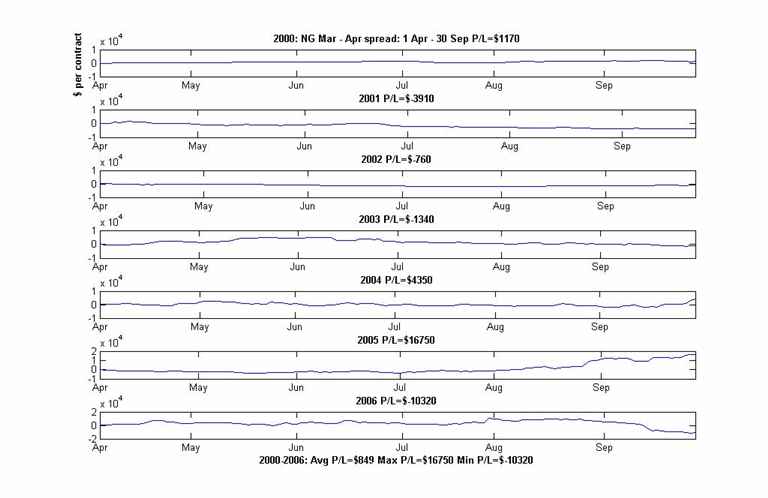A ‘Highly Improbable’ event?
Nick Maouis, the founder of Amaranth, claims that the $6
billion loss that his fund suffers is due to a “highly improbable†event in the
natural gas market. Some analysts have thrown doubts on this claim. To see how
improbable this loss is, let’s take a quick look at the historical performance
of this trade since 2000. This is not only of forensic (and perhaps legal)
interest: if Mr. Maouis’ claim were true, it would have furnished us a glimpse
of a potentially highly profitable trading strategy.
The bet that Amaranth and its head trader Brian Hunter made is that the
March-over-April spread in natural gas futures will increase in value throughout
the year prior to the contract expiration. Unfortunately for their investors,
the spread decreases rather than increases in September, resulting in a $6
billion drop in value. We don’t know the exact time when Amaranth bought this
spread. However, it is likely that they have started buying in April of this
year. April is the time when the nation’s natural gas storage inventory coming
out of the winter is known and thus provides a foundation to bet on next
winter’s natural gas sufficiency. I plotted below the profit-or-loss of buying
this spread (long one March contract of the following year, and short one April
contract) in April and exiting the position at the end of September every year
since 2000.

To my surprise, this trade loses money 3 out of 6 previous years. The one year
that this trade was very profitable is 2005: it made more than $16,000 profit
per pair of contracts. This is consistent with a Wall Street Journal report that
Mr. Hunter made $1 billion for Amaranth in 2005. That was indeed due to an
improbable event last year: Hurricane Katrina.
Note also from the 2006 graph that, consistent with news reports, the trade was
actually quite profitable up until the beginning of September. This paper profit
may not be easily realized by Mr. Hunter though, since a lot of it may be due to
his aggressively increasing his position and driving up the market.
Now there can be several objections to my analysis. You might think that if we
hold on to this spread position longer, say until December, it would have been
more profitable historically. My research shows otherwise. Holding until
December would have resulted in losing 4 out of the previous 5 years, losing
even in 2005. You might also argue that this is an extremely simplistic version
of Mr. Hunter’s strategy. No doubt Mr. Hunter used various complex options
strategies, continuously adjusted with various fundamental factors such as
weather prediction and natural gas inventory reports as inputs. However, from a
risk management point of view, the portfolio that Mr. Hunter owns seems highly
correlated to a plain vanilla spread position that I described. The fact that
this plain vanilla position loses money half the time historically would not
have been reassuring.
In a future article, I will describe some calendar spread trades in energy
futures that do have a much better profit consistency.
Ernest Chan, Ph.D. is a quantitative trader and consultant who helps his
clients implement automated, statistical trading strategies. He can be reached
through www.epchan.com. Ernie has worked as
a quantitative researcher and trader in various investment banks (Morgan
Stanley, Credit Suisse First Boston, Maple Securities) and hedge funds (Mapleridge
Capital, Millennium Partners, MANE Fund Management) since 1996. He has a Ph.D.
in physics from Cornell University.
